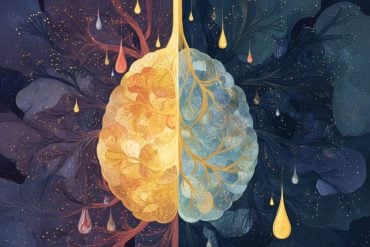Summary: A new study adds to the growing body of evidence suggesting psilocybin, a hallucinogenic compound found in certain mushroom species, could potentially revolutionize the treatment of depression and substance addiction. Researchers focused on the molecular interactions of psilocybin in the brain. The findings may help with designing new drugs that can treat a range of mental health disorders.
Source: University of Southern Denmark
Key Facts:
- Psilocybin is a hallucinogenic compound found in about 200 mushroom species and is used by scientists and therapists to treat conditions such as depression and addiction.
- The study found that psilocin binds stronger than serotonin to a 5-HT2AR serotonin receptor, which can be used to design drugs that act like psilocybin. However, the researchers caution that psilocybin should be used in safe and guiding settings led by trained therapists.
- The researchers plan to continue their research in this area and are now investigating the mechanism by which the binding of psilocybin and psilocin to receptors triggers psychoactive responses.
Psilocybin is a hallucinogenic compound found in about 200 mushroom species, including the liberty cap (Psilocybe semilanceata). For millennia, our ancestors have known and used this substance, and in recent years, it has received renewed interest from scientific researchers and therapists.
The substance has the potential to revolutionize the way we treat conditions such as severe depression and substance addiction, according to many. This is also the opinion of University of Southern Denmark researchers Himanshu Khandelia and Ali Asghar Hakami Zanjani from the Department of Physics, Chemistry and Pharmacy.
The two researchers have recently published the scientific paper The Molecular Basis of the Antidepressant Action of the Magic Mushroom extract, Psilocin.
The article is the third in a series on the same topic from the two researchers (Interaction of psychedelic tryptamine derivatives with a lipid bilayer and Magic mushroom extracts in lipid membranes).
The newest study’s co-authors are Teresa Quynh Tram Nguyen and Luise Jacobsen. The work is supported by the Lundbeck Foundation and the Novo Nordisk Foundation.
Binds stronger than serotonin
“My interest was piqued when I heard a podcast about treating smoking addiction with psilocybin. And since psilocybin mushrooms grow everywhere in Denmark – I picked some in Svanninge Bakker – it wasn’t difficult to start our research”, said Himanshu Khandelia.
Together with Ali Asghar Hakami Zanjani, he is interested in understanding what happens at the molecular level when psilocybin enters the body, is converted to psilocin, and reaches the brain.
“Previous research has shown that psilocin binds to serotonin receptors in the brain. We show that psilocin binds stronger than serotonin to a 5-HT2AR serotonin receptor. This knowledge can be used if you want to design a drug that acts like psilocybin,” explained Ali Asghar Hakami Zanjani.
The two researchers are neither neuroscientists nor pharmacists, so they currently have no plans on conducting clinical trials or designing new drugs. Their research is about studying and describing what happens at the molecular level when psilocin meets a brain cell, penetrates its membrane, and binds to receptors.
“I would be very happy if society can use our research. Maybe someone will take this further and create a molecule that can be used in medical treatment for conditions like depression,” says Himanshu Khandelia.
Zanjani and Khandelia plan to continue their research in this area, and are now investigating the mechanism by which the binding of the compounds to the receptor triggers psycho-active responses.
The time is more favorable than it has been in a long time for researchers who want to explore psilocybin treatments for conditions such as depression, addiction, anorexia, and PTSD.
Since the 1960s, many countries’ health authorities have had strict bans on researching hallucinogenic substances like psilocybin and LSD.
Prior to that, Swiss chemist Albert Hoffman had isolated psilocybin and psilocin from the P. mexicana mushroom in 1959, and the pharmaceutical company he worked for marketed and sold pure psilocybin to doctors and therapists who could then treat their patients with it.
Towards the end of the 1960s, many countries, especially the United States, tightened their legislation on psychoactive substances, and this also affected research on psilocybin and similar substances, which has been largely stagnant since the 1960s until a few years ago.
Today, countries like the United States, England, and Denmark are again active in the research field – now with a more cautious approach.
Hallucinations and the feeling of being disconnected from the world will come along whether one eats a psilocybin mushroom to take a trip or one takes the substance in a medically prescribed tablet, and this calls for caution, explains Ali Asghar Hakami Zanjani:
“Research shows that you experience something different. It is a form of hallucination. The characteristic is that patients may get a whole new perspective on their situation: for example, a terminally ill cancer patient may lose their fear of dying soon and instead experience acceptance of their life situation.
“Such sessions should take place in safe and guiding settings led by trained therapists. Today, no one would recommend just eating some mushrooms at home in their own living room”.
About this neuroscience research news
Author: Birgitte Svennevig
Source: University of Southern Denmark
Contact: Birgitte Svennevig – University of Southern Denmark
Image: The image is credited to Neuroscience News
Original Research: Open access.
“The Molecular Basis of the Antidepressant Action of the Magic Mushroom extract, Psilocin” by Himanshu Khandelia et al. Biochimica et Biophysica Acta (BBA) – Proteins and Proteomics
Abstract
The Molecular Basis of the Antidepressant Action of the Magic Mushroom extract, Psilocin
Magic mushrooms, and their extract psilocybin, are well-known for their psychedelic properties and recreational use. Psilocin, the bio-active form of psilocybin, can potentially treat various psychiatric diseases. Psilocin putatively exerts its psychedelic effect as an agonist to the serotonin 2A receptor (5-HT2AR), which is also the receptor for the neurological hormone serotonin.
The two key chemical differences between the two molecules are first, that the primary amine in serotonin is replaced with a tertiary amine in psilocin, and second, the hydroxyl group is substituted differently on the aromatic ring.
Here, we find that psilocin can bind to 5-HT2AR with an affinity higher than serotonin, and provide the molecular logic behind the higher binding affinity of psilocin using extensive molecular dynamics simulations and free energy calculations.
The binding free energy of psilocin is dependent upon the protonation states of the ligands, as well as that of the key residue in the binding site: Aspartate 155. We find that the tertiary amine of psilocin, and not the altered substitution of the hydroxyl group in the ring is responsible for the increased affinity of psilocin.
We propose design rules for effective antidepressants based on molecular insights from our simulations.







